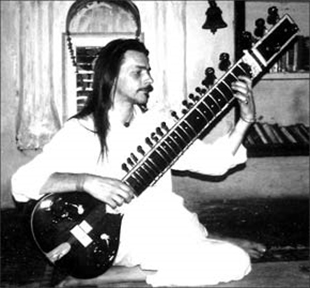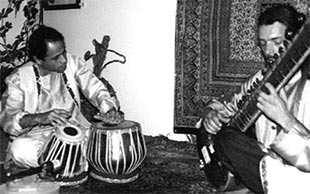The Sitar
The Sitar is probably the most known Indian stringed instrument obtained its present form approximately in the 17th century, although its invention is attributed to Amir Khushru in the 13th century. In the sixties of the 20th century, the instrument gained awareness due to Ravi Shankar and the Beatle George Harrison.
The Sitar consists of a hemispheric soundbox (a processed pumpkin) with a very long neck, which 20 flexible convex frets of metal are fixed. Four playing strings (steel respectively copper) and three bordun strings are strained over the frets. These go over a roughly 2cm board bridge, which is sanded in such a way that a preferably wide overtone spectrum can be hheard. Over the second smaller bridge are under the frets 13 strings (tarif), which get pitched to the actual raga.
The sitar is played with a metal plectrum, which is put on the right hands’s fore finger. The playing strings get ripped on the frets. The tarif strings are plucked with right hand’s little finger’s nail. A second soundbox at the upper end of the concave neck intensifies the sound and rouds it.

The Surbahar
The Surbahar, which is characterized as a bass sitar, was created by Ghulam Muhammad from Lucknow in the middle of the 19th century to make it possible to play on an instrument, which is similar to the sitar, to deep tone sequences that are specific for the drupad.
The Surbahar has a resonating box made out of wood and pumpkin, 20 metal frets, 4 playing strings, 3 rhythm strings and 13 resonating strings. It is played similar to the sitar.
I mainly play this instrument in meditation concerts.
The Tabla
The Tabla developed in the 17th century out of the Mrindangam, which is still used today in South India. It is made out of two little hand timbales that are stringed winth the skin of a goat and are played with the fingers.
The Tabla can be exactly tuned to the fundamental tone of a melodic instrument and gets thereby in ensemble playing a bright and brillant sound. Due to this characteristic, it is also called the „queen“ of the percussion instruments and is recognized and used in the modern western music today, too.
One of the bodies of the timbales persists of wood, the other one of copper or clay. The tabla play has developed an independent tone syllable language bol, which exists of about 20 syllables, which enable it to form several different rhythms linguistically.

